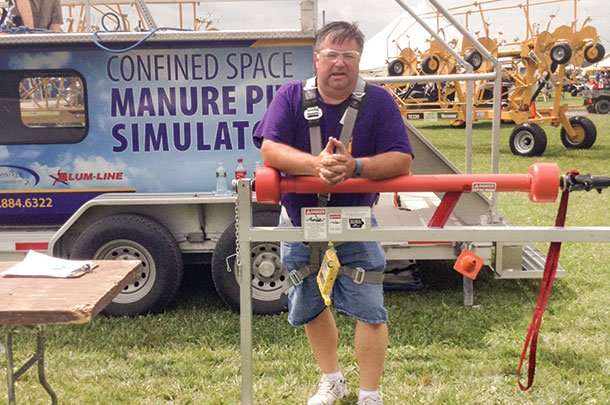It’s a hidden, silent danger on a growing number of farms across the U.S. Each year, manure pit-related incidences claim lives of farmers and their family members across the nation – and as more and more producers begin to implement these tools on their operations, the number is sure to rise.
According to Dan Neenan, director of the National Education Center for Agricultural Safety (NECAS) at Northeast Iowa Community College, more than 60 percent of those deaths are would-be rescuers who entered the confined space to assist another individual rather than calling for emergency responders.
To combat this alarming trend, the New York Center for Agricultural Medicine and Health (NYCAMH) brought the Confined Space Manure Pit Simulator to Empire Farm Days, an annual event hosted by the Empire State Potato Growers Association in Seneca Falls, New York, Aug. 11-13, 2015.
The training consisted of basic farm safety topics surrounding PTO shafts and augers, but focused primarily on proper protocol when entering a confined space such as a manure pit.
“On-farm manure storages pose a risk for injury or death not only to farmers but to those who respond to emergencies on the farm,” Neenan said in a post-training news release.
Over the course of the three-day exposition, approximately 250 farmers and emergency responders were trained in proper rescue protocols and preventative measures.
Throughout the training, Neenan demonstrated these protocols and preventative measures through use of an air quality monitoring device, a two-point harness, a rescue tripod and a 200-pound life-like mannequin.
Neenan acted as the responsible attendant and demonstrated the process of testing for air quality, attaching the harness lead to the tripod and using the tripod to bring the incapacitated “victim” to fresh, clean air until an ambulance could transport him to the hospital.
 “We like to say there are five basic rules to operating near or within a confined space,” Neenan said. “This helps to ensure that all of the basic protocols are met when the individual is contemplating entering into the manure pit.”
“We like to say there are five basic rules to operating near or within a confined space,” Neenan said. “This helps to ensure that all of the basic protocols are met when the individual is contemplating entering into the manure pit.”
These five basic rules are:
1. No individuals under the age of 18 are allowed within a confined space at any time.
2. Prior to entering the space, be sure to conduct an air quality sample using a four-gas detector, which can be rented or purchased depending on the individual’s preference.
A minimum of 19.5 percent oxygen is necessary for successful breathing while inside the space. The detector will pick up on hydrogen sulfide, ammonia, carbon monoxide and methane levels – each of which is present in great quantities within the manure pit.
3. Conduct a lock-out, tag-out of any power sources to the agitator or the pump. This will eliminate gas production during entry. Be sure to leave any fans within the pit running and even bring additional fans to keep air moving while inside.
4. Wear a harness and tie it to an outside point. Neenan suggested securing it to a piece of equipment that could be used to pull out a non-responsive individual if necessary.
5. The fifth rule is the most often broken. Neenan urged farmers to keep this rule in mind: Entering a confined space requires a minimum of two individuals.
One being the person entering the pit and the second a responsible attendant. The attendant must never enter the pit in an attempt to assist or rescue the individual inside, but must be prepared to contact and direct emergency responders should the situation demand.
“It is difficult to remember in the heat of the moment,” Neenan said. “But as the attendant, it is your job to make sure emergency responders are contacted and brought to the scene. You cannot hold your breath long enough to go down there, pull the person out and bring both of you to safety. That is not your job.”
Before entering into a potentially dangerous situation in a confined space entry, Neenan suggested farmers ask themselves this important question: Is there any way to complete the task at hand without physically entering the manure pit?
If entry is necessary, Neenan urged farmers to gather the necessary tools and assistance prior to entering the space.
“Too often the deaths or injuries we see from these manure pits could have been prevented by following just a few simple steps,” Neenan said. “This training saves lives.”
Individuals interested in learning more about the National Education Center for Agricultural Safety or the manure pit hazard simulator should visit the website. PD
Callie Curley is a communications student at Penn State University – Berks campus.
PHOTO 1: The Confined Space Manure Pit Simulator is used to demonstrate the removal of a 200-pound life-like mannequin from a confined space using an air quality monitoring device, a two-point harness and a rescue tripod.
PHOTO 2: Dan Neenan, director of the National Education Center for Agricultural Safety (NECAS) at Northeast Iowa Community College, presents manure pit safety information to attendees at Empire Farm Days. Photos by Callie Curley.







